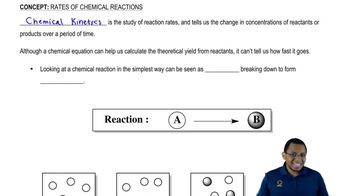Here are the essential concepts you must grasp in order to answer the question correctly.
Activation Energy (E_act)
Activation energy (E_act) is the minimum energy required for a chemical reaction to occur. It represents the energy barrier that reactants must overcome to transform into products. A lower activation energy indicates that a reaction can proceed more easily and quickly, as fewer energy collisions are needed to reach the transition state.
Recommended video:
Factors Affecting Enzyme Activity Concept 1
Reaction Rate
The reaction rate refers to the speed at which reactants are converted into products in a chemical reaction. It is influenced by several factors, including temperature, concentration, and the presence of catalysts. Generally, reactions with lower activation energies have higher rates because they require less energy to initiate.
Recommended video:
Rate of Reaction Concept 1
Arrhenius Equation
The Arrhenius equation describes the relationship between the rate constant of a reaction and its activation energy, temperature, and a pre-exponential factor. It is expressed as k = A * e^(-E_act/RT), where k is the rate constant, A is the frequency factor, R is the gas constant, and T is the temperature in Kelvin. This equation illustrates that as activation energy decreases, the rate constant increases, leading to faster reactions.
Recommended video:
Arrhenius Acids & Bases Concept 1
 Verified Solution
Verified Solution



 2:40m
2:40m
